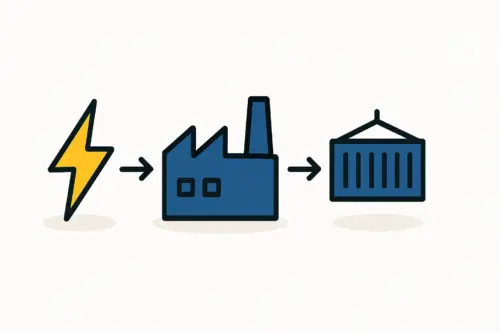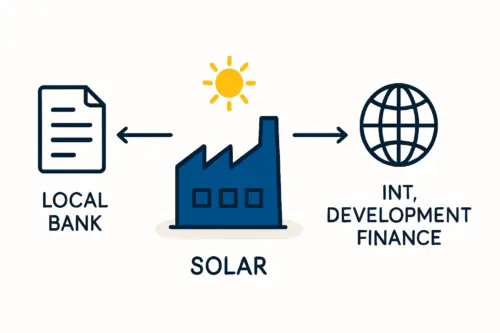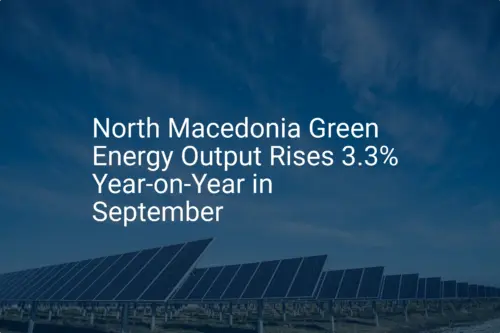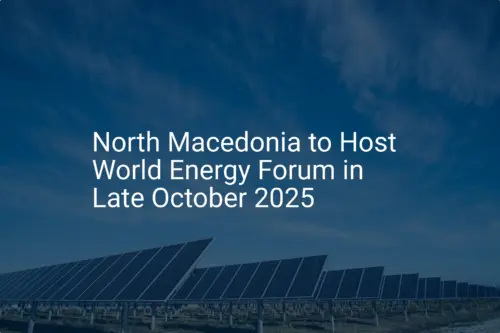An investor looks at a new market not just for its potential, but for its predictability. In the rapidly evolving energy sector of the Balkan Peninsula, North Macedonia presents a compelling case.
With a government committed to phasing out coal by 2027 and achieving 46% renewable energy by 2030, the country has created clear demand for solar energy infrastructure. For an entrepreneur entering this market, however, the primary question shifts from opportunity to process: What are the precise steps required to establish a compliant and successful solar module factory?
This guide provides a structured overview of that legal and administrative pathway, breaking down the complexities of local regulations into a clear, phased approach.
A Phased Approach to Licensing and Permits
Launching a solar manufacturing facility in North Macedonia involves a sequence of approvals from various governmental bodies. While the process is detailed, it follows a logical progression.
It begins with establishing a legal entity and securing a location, moves on to obtaining construction approval, and culminates in the license to produce. Understanding this sequence is fundamental for effective project planning and execution.
Phase 1: Corporate and Legal Foundation
Before any land can be acquired or plans submitted, an investor must establish a legal presence in the country. The entire process is managed through the Central Registry of the Republic of North Macedonia.
Foreign investors have the same rights and obligations as domestic entities. The most common corporate structures for this type of venture are:
- Limited Liability Company (DOO or DOOEL): A flexible and common choice for small to medium-sized enterprises, offering protection for personal assets.
- Joint Stock Company (AD): More suitable for larger operations that may intend to raise capital publicly.
Company registration is the foundation on which all subsequent permits and licenses are built.
Phase 2: Securing the Location and Construction Approval
Once a legal entity is established, the focus shifts to the physical facility. This phase involves two critical permits:
-
Location Permit: This is obtained at the municipal level. The proposed factory location must align with local and national urban plans. Diligence at this stage is crucial, as a non-compliant location can halt a project indefinitely.
Ready to make big Profits?
The solar Industry is Booming
WE HELP NEWCOMERS to the solar industry start their own solar module production line. Customers can make BIG PROFITS by selling modules and finding investors, without wasting money and time on things they don't need!
-
Construction Permit: This more complex step requires detailed technical documentation. A key prerequisite is the preparation of an ‘Elaborate’—a comprehensive environmental impact assessment report. This report must be submitted to and approved by the Ministry of Environment and Physical Planning (MOEPP). Approval confirms that the factory’s design and operational plans meet national environmental standards.
Based on J.v.G. Technology’s experience with turnkey projects, having a detailed layout for the turnkey solar manufacturing line at this stage significantly streamlines the technical submissions for the construction permit.

Phase 3: Obtaining the Electricity Production License
This is the final and most significant regulatory milestone. The license to produce and sell solar modules is issued by the Energy and Water Services Regulatory Commission (ERC), the country’s primary energy regulator.
To apply, the investor must demonstrate that:
- The facility is fully constructed and compliant with the approved plans.
- The company holds the legal right to use the land and building, either through ownership or a long-term lease.
Once granted, this license is typically valid for up to 35 years, providing the long-term operational security needed for a significant capital investment.
A Key Advantage: Technological Industrial Development Zones (TIDZs)
The government of North Macedonia actively encourages foreign investment through a network of Technological Industrial Development Zones (TIDZs). These are specially designated areas that offer a highly favorable business environment, designed to attract manufacturing and technology companies.
For an investor planning a solar factory, locating within a TIDZ can dramatically improve the project’s financial viability.
Key benefits offered within these zones often include:
- 10-Year Tax Holiday: Exemption from corporate and personal income tax for the first decade of operation.
- VAT and Customs Exemptions: No value-added tax or customs duties on the import of equipment, machinery, and raw materials. This significantly reduces the initial investment for a solar factory.
- Construction Subsidies: Potential financial support for the construction of the manufacturing facility.
- Streamlined Administration: A ‘one-stop-shop’ service to simplify administrative and customs procedures.

Common Challenges and How to Prepare
While the regulatory framework is well-defined, new investors should be aware of potential challenges.
- Bureaucratic Navigation: As in many jurisdictions, administrative processes can involve delays. Engaging experienced local legal and business consultants is not just an advantage—it is essential for navigating the system efficiently.
- Documentation Rigor: The quality and completeness of all submitted documents are paramount. A comprehensive business plan for a solar factory and precise technical specifications are required from the outset.
- Regulatory Updates: North Macedonia’s energy sector is dynamic. Investors must stay informed about any changes to the Law on Energy or related regulations that could impact their operations.
Frequently Asked Questions (FAQ)
-
How long does the entire permitting and licensing process typically take?
While timelines can vary, a well-prepared investor should realistically budget for 12 to 18 months from company registration to the issuance of the final production license. -
Is a local partner in North Macedonia required for a foreign investor?
A local partner is not legally required. However, partnering with local consultants or legal advisors who understand the nuances of the administrative system is highly recommended to avoid common pitfalls and delays. -
What is the primary role of the Energy and Water Services Regulatory Commission (ERC)?
The ERC is the independent body responsible for regulating the energy sector. Its key functions include issuing licenses for energy production, setting tariffs, and ensuring a stable and competitive energy market. -
Are the incentives in the TIDZs guaranteed for all foreign investors?
The incentives are available to investors who meet the specific criteria for operating within a TIDZ. This typically involves commitments related to investment size, job creation, and the nature of the business (e.g., manufacturing, technology). The application is reviewed and approved by the Directorate for TIDZ.
The Final Objective: An Operational Facility
Navigating the permitting process is a means to an end: a state-of-the-art manufacturing facility capable of producing high-quality solar modules for a growing market. Each step, from the environmental report to the final license, is designed to ensure the operation’s long-term sustainability and compliance.
A thorough understanding of the solar module manufacturing process is vital, as this technical knowledge informs the facility design and the documentation required for the permits. By aligning a project’s technical plan with the country’s regulatory roadmap, an investor can proceed with confidence.

Next Steps in Your Planning Journey
With this regulatory overview, your next steps should involve deeper, more specific planning. This includes developing a detailed financial model, initiating contact with local legal and business advisory firms in North Macedonia, and beginning the technical specification process for the factory itself.
Platforms like pvknowhow.com offer structured educational resources, including an e-course, to help entrepreneurs without a technical background confidently manage these subsequent phases of project development.






